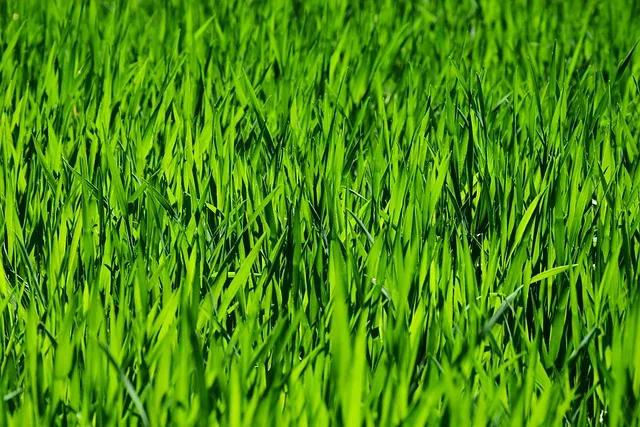A well-maintained lawn and strategic landscaping design are integral to creating an aesthetically pleasing, ecologically beneficial, and low-maintenance outdoor space. Key to this is understanding and optimizing local soil conditions, sunlight exposure, and grass type selection for robust root growth and a thriving landscape. Regular mowing at the correct height, along with aeration and overseeding, helps prevent turf compaction and pest issues, while tailored irrigation and fertilization practices ensure optimal hydration and nutrient levels without excess. Pest and disease management require vigilance and prompt action to maintain a healthy lawn. Integrating mulch beds not only outlines spaces but also reduces the need for intensive turf maintenance. A holistic approach to lawn care, including these practices, supports biodiversity, enhances environmental health, and contributes to a vibrant landscape. Strategic planning in lawn care and landscaping is essential for transforming outdoor areas into harmonious, functional spaces that combine form and function with minimal maintenance, offering year-round appeal and significantly boosting property value over time through thoughtful design and sustainable practices like xeriscaping.
Embark on a journey through the greenery of your yard with our comprehensive guide on landscaping design and implementation. This article delves into the art of lawn care and strategic planning, offering you essential principles to cultivate a thriving landscape. Learn how to execute your gardening vision with precision and flair in “Implementing Your Landscaping Vision: Execution Tips for a Successful Garden Transformation.” Transform your outdoor space into a verdant oasis with insights from “Essential Principles of Effective Lawn Care for a Thriving Landscape” and master the nuances of design with our strategic planning advice. Elevate your garden’s potential with practical, actionable tips that ensure lush results all year round.
- Essential Principles of Effective Lawn Care for a Thriving Landscape
- Strategic Planning in Landscaping Design to Enhance Your Outdoor Space
- Implementing Your Landscaping Vision: Execution Tips for a Successful Garden Transformation
Essential Principles of Effective Lawn Care for a Thriving Landscape

Engaging in meticulous lawn care is a cornerstone of cultivating a thriving landscape. A lush, vibrant lawn not only enhances the aesthetic appeal of your property but also provides ecological benefits and improves air quality by increasing oxygen production through photosynthesis. The principles of effective lawn care revolve around understanding soil composition, optimizing sunlight exposure, and selecting grass varieties that are well-suited to local climate conditions. Regular mowing at the appropriate height for your grass type encourages root growth and reduces the risk of weeds taking over. Aeration and overseeding can prevent compaction and maintain a thick turf that naturally deters pests and diseases.
In addition to routine maintenance, lawn care is also about proactive strategies such as irrigation management to ensure hydration without waste, and fertilization at the right times to provide nutrients for healthy growth. Pest and disease management involves timely identification and treatment to protect your lawn from unwanted intruders. Landscaping design elements like the integration of mulch beds can help delineate areas and reduce turf maintenance demands. By adopting a holistic approach to lawn care, you’re not only nurturing a green space but also contributing to the health and biodiversity of your environment. Embracing these practices will lead to a landscape that is both beautiful and sustainable.
Strategic Planning in Landscaping Design to Enhance Your Outdoor Space

Incorporating strategic planning into landscaping design is a pivotal step to transform your outdoor space into a harmonious and functional haven. This process begins with a comprehensive assessment of your property, taking into account factors such as soil type, sunlight exposure, and topography. Lawn care and landscaping are not isolated tasks but interconnected components of a larger plan that culminates in a thriving landscape. A well-designed lawn care regimen forms the foundation of a healthy, vibrant lawn, which serves as the canvas upon which garden elements can be artfully placed. By understanding the specific needs of your turf and ornamental plants, you can tailor your landscaping design to ensure year-round interest and minimal maintenance requirements. Strategic planning also involves considering the transition between different spaces – from patios to gardens to play areas – to create a seamless flow that enhances the overall aesthetic appeal and usability of your outdoor environment.
To further refine your landscape, consider elements such as hardscaping, which can include pathways, retaining walls, or water features. These elements not only add visual interest but also serve practical functions, like directing water away from your home during heavy rains. Additionally, thoughtful placement of lighting can extend the enjoyment of your outdoor space into the evening hours. By integrating these components into your strategic plan, you can create an outdoor space that is both beautiful and functional, reflecting a careful balance between form and function. Lawn care and landscaping, when approached with intentionality and foresight, are investments in the value and appeal of your property, ensuring that your outdoor space remains a source of enjoyment for years to come.
Implementing Your Landscaping Vision: Execution Tips for a Successful Garden Transformation

Embarking on a garden transformation that brings your landscaping vision to life can be an exhilarating endeavor. To ensure a successful and flourishing outdoor space, meticulous planning and thoughtful execution are key. Begin by assessing your lawn’s current condition; identify areas for improvement and consider the type of landscape design that will complement your property’s unique characteristics. Lawn Care and Landscaping practices are fundamental to establishing a healthy foundation for your garden. Prioritize tasks such as soil testing, which informs you about the nutrient levels and pH balance necessary for optimal plant growth.
Once you have a clear understanding of your lawn’s needs, select plants that thrive in your local climate and are well-suited to the amount of sunlight your garden receives. Integrate these with hardscaping elements like pathways, water features, or retaining walls to create a cohesive design. When implementing these elements, ensure they enhance the aesthetic appeal while serving functional purposes. For instance, strategically placed boulders can anchor a landscape and provide visual interest, while also helping to manage soil erosion.
Throughout the landscaping process, remember to incorporate sustainable practices such as xeriscaping, which minimizes the need for supplemental watering by using drought-resistant plants. Additionally, consider the use of mulch to conserve soil moisture and reduce maintenance time. By combining thoughtful design with careful planning and attentive lawn care, you can achieve a garden that not only reflects your personal style but also stands as a testament to harmonious living and environmental stewardship.
Lawn Care and landscaping design play pivotal roles in creating an outdoor space that is both visually appealing and ecologically harmonious. By adhering to the essential principles of effective lawn care, homeowners can foster a thriving landscape that serves as a foundation for a well-designed garden. Strategic planning is key when crafting a landscaping vision, ensuring that every element complements the next, and contributes to the overall aesthetic and functionality of the space. Implementation tips provided in this article guide readers through the transformation process, turning their garden into a living masterpiece. With careful attention to lawn care maintenance and thoughtful design choices, anyone can achieve a landscape that not only enhances their property’s value but also provides a serene retreat for years to come.
